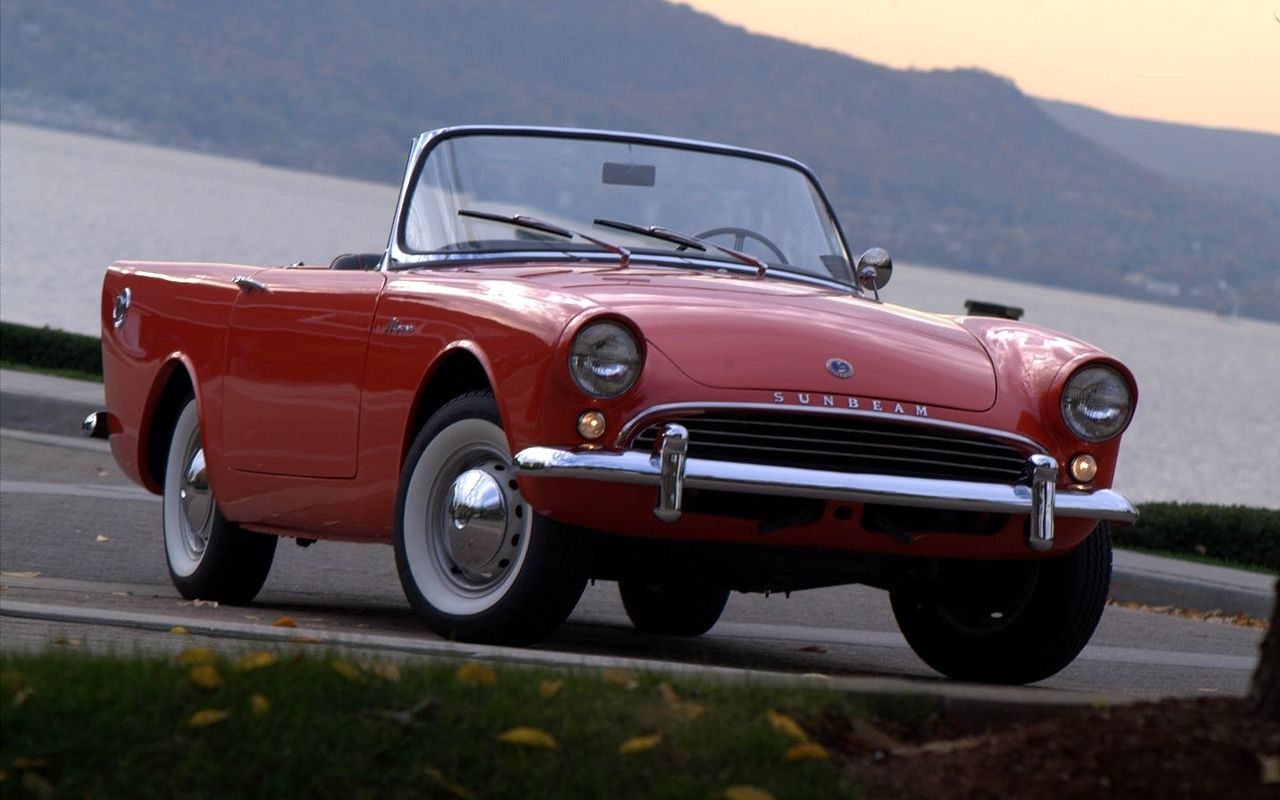The name Sunbeam Alpine may not be super popular in the automotive industry. Still, we saw this sports roadster in many famous movies, where stars like Sean Connery, Elizabeth Taylor, and even Arnold Schwarzenegger drove it!
Source: Wallpaper Flare
When talking about James Bond and his spectacular automobiles, Aston Martins always come to mind. However, few know that Bond’s first car on the big screen was a second-generation blue Sunbeam Alpine, which appeared in the first car chase scene. For the first time, James Bond appeared in a sports vehicle that today almost no one knows. However, then, in the 60s, this model was quite popular in Britain. The company was founded in 1888. Initially, it produced motorcycles but later switched to working on automobiles. In 1920, it passed to a French entrepreneur and business owner Alexandre Darracq. In general, this car not only became the king of roads and rallies but also a super stylish and beautiful automobile for various films and TV shows. No wonder the British two-seater sports car was filmed in the iconic blockbusters and television series of its time!

Source: FavCars
This sporty automobile appeared as a rally star and got its name after the Alpine Rally victories won by Sunbeam-Talbot in the 1950s. At some whim of the brand’s owners, the Rootes Group, in 1953 it was decided to drop the Talbot name, and the vehicle entered the market without any French surnames there. In March 1953 the car debuted owing its birth to a brand dealer named George Hartwell. Back in 1952, Hartwell, who specialized in sports versions of the Sunbeam-Talbot brand, transformed a 90 MkII convertible into a two-seat roadster, which was sold as the Hartwell Coupe. In addition to the body, the engine was also reworked, which received a different head and intake manifold, thanks to which another 3 l/s was removed, increasing the output to 80 l/s, which allowed the vehicle to accelerate up to 153 km/h. The Roots brothers, who run the Sunbeam company, liked the automobile, and in the spring of 1953, they decided to offer this automobile to their customers in the USA. The chassis of the new automobile was made a little stiffer, improving the handling, and the bodies, which were finalized by Raymond Loevy, were supplied by Mulliners from Birmingham. Remarkably, the roadster was assembled by hand at the bodywork firm Thrupp & Maberley. Since the British economy was then in a difficult condition, two-thirds of the production went for export. The new roadster immediately made its debut on rally tracks, winning several famous racing competitions, including “Coupe Des Dames”, won by Sheila van Damm.
The first generation was built based on the Hillman Husky, which was a shortened version of the Hillman Minx, but with a 1.5L 78hp unit installed under the hood, and front brake discs. The first generation of this automobile could reach 100 miles per hour (161 km/h) and accelerate to hundreds in 13 seconds. The roadster was very well assembled and expensively finished compared to its closest competitors from MG or Triumph. In 1960, Alpine production was moved to Ryton, where a new 1.6l engine with a capacity of 80hp was installed. During the whole production period, 5 generations of this British sports vehicle had been produced, including the famous Tiger modification, designed by auto designer and racing driver Carroll Shelby.
Source: WallpaperUp
The last generation of Alpine was compact and perfect for export. Despite having less power than its competitors, it had excellent finishes and equipment, a smooth ride, directional stability, and a pleasant character. The 1959-1968 model was designed by Kenneth Howes and Jeff Crompton without reference to any other Rootes Group model, although many technical components were borrowed from the Rapier and Hillman Husky models. The design of the roadster was commissioned by Raymond Loewy Studios, but the automobile turned out to be similar to the 1955-1957 Ford Thunderbird, because of the Howes influence, who previously worked at Ford. The vehicle was equipped with an inline 4-cylinder OHV engine, which in 1967 was increased to a volume of 1724 cm3, with a power of up to 93 hp. The car also received a more spacious trunk, and the list of options included a removable hard top. The 1967 model no longer offered an automatic transmission: only the 4-speed manual version remained. Later, Chrysler, which bought the British company in the late 60s, explained the decision to stop production of the model because of its unprofitability. However, the numbers spoke for themselves: the total number of produced vehicles from each generation was – 11904 “Series I”, 19956 – “Series II”, 5863 – ” Series III”, 12406 – “Series IV” and 19122 – “Series V”. The model was the last Rootes-Chrysler sports car with an open body.
Source: Barons-Auctions
Following the success of the AC Cobra, Carroll Shelby proposed a similar V8 engine transplant into a production Alpine sports car. The modification was named Tiger and was produced for 4 years. 1967 was the last year of production of this “wolf in sheep’s clothing”, capable of accelerating to 196 km / h.
Contact us if you have this or another classic car to sell.